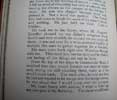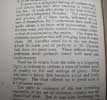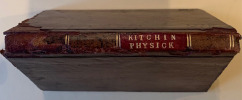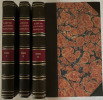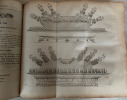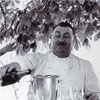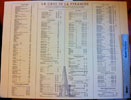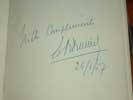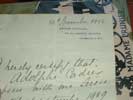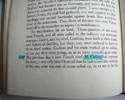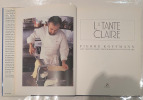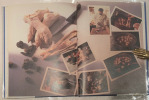Dubois.
Urbain & Emile Bernard
La Cuisine Classique
VOLUME 1: LA CUISINE CLASSIQUE ETUDES PRATIQUES, RAISONNEES ET DEMONSTRATIVES D'ECOLE FRANCAISE URBAIN DUBOIS & EMILE BERNARD CHEFS DE CUISINE DE LL. MM. L'EMPEREUR ET L'EMPERATRICE D'ALLEMAGNE OUVERAGE ILLUSTRE DE 76 PLANCHES GRAVEES ET UN FRONTISPICE EMBRASSANT DANS SON CADRE TOUTS LES PRESCRIPTIONS THEORIQUES, D'APRES L'ORDRE ET LES PRINCIPES DE LA GRANDE CUISINE En cuisine, en peut briller selon sen aptitude, par le luxe, la variete, le gout parfait, les soins delicats; mais, parmi les qualite indispensables au practicion, nous mettons, en premier ligne, la science organisatrice et la connaissance approfondie de toutes les branches de l'art. TOME PREMIER DIXIEME EDITION PARIS E. DENTU, EDITEUR, PALAIS-ROYAL ET CHEZ TOUS LES PRINCIPAUX LIBRAIRES 1884 DROITS DE TRADUCTION ET REPRODUCTION RESERVES -- VOLUME 2: LA CUISINE CLASSIQUE ETUDES PRATIQUES, RAISONNEES ET DEMONSTRATIVES D'ECOLE FRANCAISE URBAIN DUBOIS & EMILE BERNARD CHEFS DE CUISINE DE LL. MM. L'EMPEREUR ET L'EMPERATRICE D'ALLEMAGNE OUVERAGE ILLUSTRE DE 76 PLANCHES GRAVEES ET UN FRONTISPICE EMBRASSANT DANS SON CADRE TOUTS LES PRESCRIPTIONS THEORIQUES, D'APRES L'ORDRE ET LES PRINCIPES DE LA GRANDE CUISINE En cuisine, en peut briller selon sen aptitude, par le luxe, la variete, le gout parfait, les soins delicats; mais, parmi les qualite indispensables au practicion, nous mettons, en premier ligne, la science organisatrice et la connaissance approfondie de toutes les branches de l'art. TOME SECOND DIXIEME EDITION PARIS E. DENTU, EDITEUR, PALAIS-ROYAL ET CHEZ TOUS LES PRINCIPAUX LIBRAIRES 1884 DROITS DE TRADUCTION ET REPRODUCTION RESERVES.
The 10th Edition; Large 4to. 307x250mm. VOLUME 1: Front paste-down and endpaper marbled. [1] 1fep. Half title. (1)Printers device. Engraved Frontispiece. [1] Title page. Verso with facsimile signature of Dubois. Half title for dedication. [1] Dedication a leurs Majestes de Prusse. [1] (1)x Preface to 1st edition. (1)xii Preface to 2nd edition. (1)xiv Preface to 8th edition. (1)xvi-xviii La Service a la Francaise. (1)xx-lxiv Menus. (1)2-421. [1]424-433 Table des Matieres. [1] 1p Table des Planches. [1] 1fep. Endpaper and back paste-down marbled. With 29 full page planches. Boards marbled with edges very slightly scuffed. Spine with black leather, raised bands and gilt lettering. Internally and externally very clean. VOLUME 2: Front paste-down and endpaper marbled. [1] 1fep. Half title. (1)Printers device. Title page. Verso with facsimile signature of Dubois. (1)2-526. [1]528-537 Table des Matieres. [1] 1p Table des Planches. [1] 1fep. Endpaper and back paste-down marbled. With 48 full page planches. (A total in both volumes of 77 planches). Boards marbled with edges very slightly scuffed. Spine with black leather, raised bands and gilt lettering. Internally and externally very clean. A handsome set of a magnificent cookery books. The fine engraved plates are incomparable.
-
'La Cuisine Classique' first published - 1856. Dubois' and Bernard's great classic, records a progressive step up from the style of French cookery based on the work of Marie Antonin Careme. These were simplifications and refinements (albeit still very complicated) of the early work of Carême. It was practised mainly in embassies, the grand houses of the titled and elite and also the royal palaces of Europe for much of the 19th and first half of the 20th century. The major developments were to replace service à la Française (serving all dishes at once) with service à la Russe (serving meals in courses but still on platters) and to develop a system of cookery which formalized the preparation of dishes with their sauces and garnishes. In its time, it was considered the pinnacle of haute cuisine, and it was a style distinct from cuisine bourgeoise (cuisine for families with cooks) the working-class cuisine of bistros and homes, and the cuisines of the the French provinces.
Cuisine classique came under heavy criticism in 1972 from the food critics Henri Gault and Christian Milleau, for its rigidity, and penchant for elaborate, multi-layered preparations and heavily cooked foods, and an often whimsical and cryptic naming scheme for dishes. While restaurants serving cuisine classique are now generally considered stodgy anachronisms (if indeed there are any left) – they were supplanted by dining rooms serving nouvelle cuisine, where from the chef's point of view the biggest difference was serving the whole course on one plate. There has also been a revival of interest in provincial cooking (cuisine du terroir) and newer styles. La cuisine classique has had a decisive impact on cuisine as a whole. The cooking techniques of cuisine classique (but not the final assembly) still form the basis of most culinary educations, and the recipes of Escoffier's -'Le Guide Culinaire' and the combinations of the 'Le Repertoire de la Cuisine' are still used as a vital starting point in cooking versions of the French classics better suited to modern tastes. Those books and guides may not be consulted so much nowadays, but their lasting impact cannot be ignored, as every good French meal served today owes its creation, in large part to those times. It may be argued that there are no absolute original dishes, but rather, what we are served today is an amalgamation and progression of culinary techniques, advances in H&S and refridgeration, improved equipment and market availability since man hunted with spears. Our real debt is to those master cooks who imparted and maintained the highest standards possible and also left behind from their time, a written legacy of their knowledge and craft, that in turn influences and inspires the next generations. These two magnificent volumes from Dubois & Bernard cannot help but amaze; truly a different time.






|
|

Antiquarian category
ref number:
11030
|


